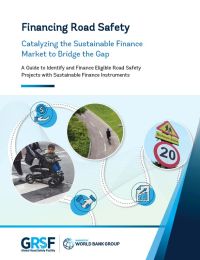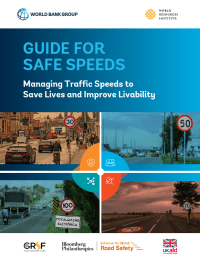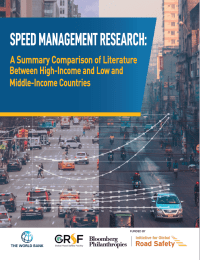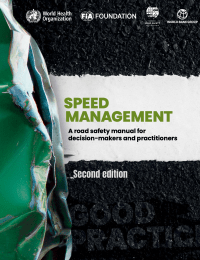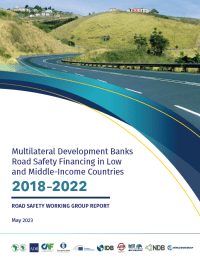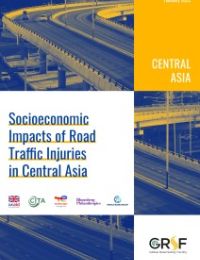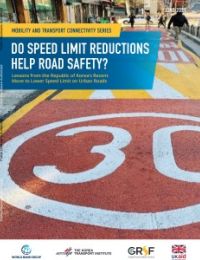Publications
1-10 of 17
-
Economics & Finance
Financing Road Safety: Catalyzing the Sustainable Finance Market to Bridge the Gap
February 2025
-
Speed Management
Guide for Safe Speeds: Managing Traffic Speeds to Save Lives and Improve Livability
March 2024
-
Speed Management
Speed Management Research: A Summary Comparison of Literature Between High-Income and Low and Middle-Income Countries
February 2024
-
Speed Management
Speed Management: A Road Safety Manual for Decision-Makers and Practitioners (2nd ed.)
November 2023
-
Economics & Finance
Multilateral Development Banks Road Safety Financing in Low and Middle-Income Countries: 2018–2022
May 2023
-
-
-
Speed Management
Road Crash Trauma, Climate Change, Pollution and the Total Costs of Speed: Six Graphs That Tell the Story
July 2022
-
Speed Management
Guide for Determining Readiness for Speed Cameras and Other Automated Enforcement
July 2022
-
To briefly identify the powerful practical value of AE in saving lives and reducing injuries.
-
To identify issues and criteria to be considered before commencing automated enforcement. To identify steps to be taken to achieve readiness for automated enforcement. To identify issues to improve existing automated enforcement systems.
-
To provide a checklist to ensure adequate consideration is given to issues to assess readiness to implement an AE system or improve an existing system.
- Evaluate the effectiveness of the reduced speed limits in terms of crash reduction through a before-after study.
- Examine if the speed limit change had different effects across different crash types, user types, and crash severities.
- Evaluate the impact of speed limit change on transit speed through a before-after assessment.
- Develop appropriate and actionable recommendations for departments of transportation in developing countries.
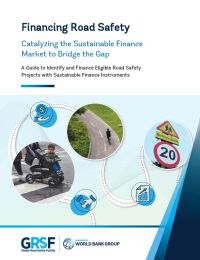
The burden of road traffic injuries is a significant global challenge requiring urgent attention and investment. By integrating road safety investments with broader development goals and leveraging innovative financing solutions such as labeled sustainable bonds and loans, available financing for road safety projects can be dramatically increased.
The societal, economic, and human benefits of improving road safety are extensive, making it a critical priority for national agendas. Through strategic investments in road safety, economic burdens can be mitigated, long-term growth promoted, and a safer, more equitable world created for all.
The multilateral development banks -- together with the Global Road Safety Facility and with strong donor support -- can help countries catalyze the sustainable finance market to fund high-impact and results-oriented road safety projects.

Speed is one of the main road safety risk factors and is universally recognized as the leading contributor to road fatalities and serious injuries. But there is good news: the speed problem is solvable. Interventions that are proven to be effective exist, and it is well understood where and how they should be applied.
The newly published “Guide for Safe Speeds: Managing Traffic Speeds to Save Lives and Improve Livability” outlines interventions that work and provides guidance on how to select and implement speed limits that are safe for all road users. It also explains how barriers to changing traffic speeds—which are often based on lack of knowledge or misunderstandings—can be overcome.
A primary feature of the guide is its comprehensiveness. The guide covers all types of roads—from city streets to inter-urban roads and motorways (existing or new); all types of road users—from vulnerable road users such as pedestrians and cyclists to heavy motorized traffic; all types of speed limit changes—from national general speed limits to localized changes based on risk factors; all types of challenging constraints—from lack of resources to lack of data; and all types of countries—from low-income to high-income.
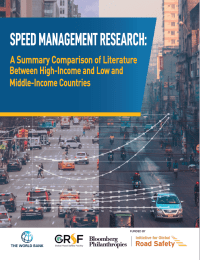
Low- and middle-income countries (LMICs) have been experiencing growth in vehicle travel and mobility but have not yet realized road safety gains experienced by high-income countries. Excessive and inappropriate speed is known to be a major cause of road crashes, injuries and deaths. Thus, speed management is considered a key initiative for improving road safety outcomes worldwide and has been applied successfully in most high-income countries.
Proven interventions do not necessarily have the same impacts in LMICs, or may not be feasible to apply, due significant differences in traffic mix, road user behavior, road design and vehicle standards.
This document summarizes current available knowledge about speed, its effects on safety, mobility and emissions, along with potential safety effectiveness of speed management initiatives in the LMIC context. Knowledge gaps for LMICs are clearly referenced for further consideration.
The knowledge summary provides a useful reference for practitioners wishing to inform themselves about traffic speeds, their selection and impacts on safety outcomes, mobility and emissions. The LMIC knowledge gaps will be useful in considering future research and data priorities.

The WHO, World Bank, FIA Foundation and Global Road Safety Partnership (GRSP) produced a series of good practice manuals, following the publication of the World report on road traffic injury prevention in 2004, which provide guidance on implementation of interventions to address specific risk factors in road safety. The topics covered in the initial series of manuals were: helmets (2006), drinking and driving (2007), speed management (2008), seat-belts and child restraints (2009), data systems (2010), pedestrian safety (2013), road safety legislation (2013), powered two- and three-wheeler safety (2017) and cyclist safety (2020).
Since the series of manuals was first published, the scientific evidence base relating to various risk factors and the effectiveness of interventions have continued expanding. Contemporary research has refined our knowledge about specific risk factors, such as distracted driving, and vehicle impact speed and risk of death for pedestrians. New issues and practices have arisen, such as a tropical helmet standard and an anti-braking control standard for motorcycles. New and existing interventions have been implemented and evaluated, with increasing application in LMICs. Research attention and policy response have also increasingly been applied to emerging road safety issues including e-bikes, drugs other than alcohol, fleet safety, urban mobility, micro mobility options, air and noise pollution, public transport and technological advances.
As a result of these developments, the good practice manuals required revision so that they can continue to be key references for road safety policy implementation and research. This is particularly important, given the emphasis placed on road safety within the framework of the 2030 Agenda for Sustainable Development and because of the global impetus to reduce road deaths and injuries, resulting from the declaration of the two United Nations’ Decades of Action for Road Safety (2011–2020 and 2021– 2030). The manuals have been revised to reflect these developments as they continue to be valuable resources providing evidence-based and cost-effective solutions to save lives and reduce injuries.
The management of speed remains one of the biggest challenges facing road safety practitioners around the world and calls for a concerted, long-term, multidisciplinary response. The speed at which a vehicle travels directly influences the risk of a crash as well as the severity of injuries sustained, and the likelihood of death resulting from that crash. This manual advocates for a strong and strategic approach to creating a Safe System, with speed management at its heart. Reducing motor vehicle speeds in areas where the road user mix includes a high volume of vulnerable road users, such as pedestrians and cyclists, and on non-divided rural roads, is especially important.
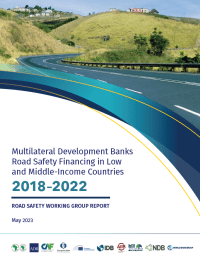
The Multilateral Development Banks (MDBs) Road Safety Working Group, established in 2009, is comprised of ten member institutions that are uniquely positioned to support countries in reaching their considerable and challenging road safety financing needs.
In early 2023, the working group reviewed progress made by the MDBs in financing road safety activities in low and middle-income countries (LMICs), and found that MDBs collectively committed $3.6 billion toward road safety initiatives in developing countries during the period 2018-2022. Three standalone road safety projects—in Bangladesh (World Bank), India (Asian Development Bank and World Bank), and Romania (European Investment Bank)—totaled $912 million in MDBs financing, which is more than one-quarter of the amount committed during this timeframe.
The review is based on details of road and urban mobility project financing provided by seven of the working group's ten members.
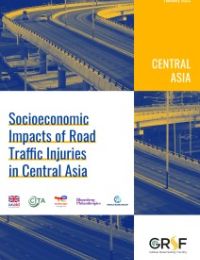
Road traffic injuries (RTIs) are well known to cause enormous human suffering in terms of both morbidity and mortality, and on a global scale. The economic dimension of the disease burden is far less well understood; but it is important to assess the size of the economic burden so that it can be considered when calculating the cost-benefit ratio of policies to tackle this problem. Because it is, in principle, and to some degree, an avoidable one.
This report focuses primarily on assessing various dimensions of the economic consequences of RTIs, as applied specifically to four Central Asian countries (Kazakhstan, Kyrgyzstan, Tajikistan, and Uzbekistan) – a part of the world in which there is still a major need to reduce RTIs.
This study shows that on top of the harm RTIs inflict upon human health, they also impose a considerable financial burden on health care systems. In 2016, the total estimated health costs of RTIs in these four countries was approximately Int$95 million, ranging from Int$2.8million in Tajikistan to Int$49.3 million in Kazakhstan. In Kazakhstan, the overall health costs resulting from RTIs were similar to the cumulative expenditure for rehabilitative and palliative care within the state-guaranteed basic package. The heavy financial burden on health care systems to manage RTIs in these countries adds weight to the urgency to increase preventive efforts by road safety policymakers, and should motivate appropriate organization of the post-crash response by health care system decision makers. The cost estimates discussed in this report indicate the potential for significant economic cost savings if both deaths and injuries from road crashes could be substantially reduced in these countries.

The World Bank estimates a significant funding gap in road safety of 260 billion to achieve SDG 3.6 and 11.2 in the next ten years, and recognizes that this gap cannot be closed through public funding alone and thus mobilization of private capital is required. The impacts of road traffic crashes reach far into the economy and can cost L/MICs as much as 6% of their GDP. The costs of a road traffic crash do not end at the roadside; they create ripple effects throughout the wider economy. Loss of income, property damage, insurance premiums, loss of taxes, and burdens on the health sector are just some of the far-reaching costs associated with road traffic crashes. Road traffic crashes can cost countries as much as 6 percent of their GDP and trap families in poverty as they lose income generating potential and focus on providing lifetime care.
This report examines the potential for private capital mobilization to close this gap. The report investigates the market failure to appropriately account for the cost of road crashes, which prevents private capital from flowing to road safety investments. The growth of socially responsible investing and the sustainable finance market offers a new opportunity to address this market failure. The report proposes different business models and financing instruments to channel private investment into road safety projects. These investment structures consist of subnational, public-private partnerships (PPPs) and corporate investments that can leverage the growing sustainable finance market, including social and sustainability-linked financings (SLFs).
The report also develops indicators that can be used to tie the cost of financing to the attainment of road safety targets, incentivizing borrowers to commit to road safety as part of SLFs. The report examines the enabling environment for structuring investable road safety projects in a sample of countries, looking at the barriers and opportunities, and proposing risks and mitigation strategies, like blended finance mechanisms and stable revenue sources, for long-term sustainability of road safety investments.

What is the real cost of speeding on people and the environment? These 6 graphs tell the story ⌵︎
The impacts of speed on the safety of road users, on congestion, on pollution, and on total costs of road travel are broadly misunderstood: often based on wrong assumptions, with effects taken as self-evident, failure to consider multiple impacts, externalization of costs by many stakeholders, and under-estimation of impacts (especially economic costs of higher speeds). The purpose of this brief note is to provide information on these relationships relevant to fundamental road transport policies, design, and operation. Well-established evidence shows the importance of managing travel speeds for road safety, for efficiency, for improved inclusion, and for greenhouse gas (GHG) and other emissions. Thus, speed management is a strong policy lever for the breadth of issues which must be addressed for sustainable mobility.
Reduced speeds of travel represent a major, yet under-appreciated, opportunity to improve safety, climate change impacts of travel, health, inclusion, the economy, and in some circumstances, congestion. Speed management can be achieved through a range of interventions including road infrastructure and vehicle technology, as well as enforcement and promotion.
The six graphs presented in this note tell a powerful story, across the range of these benefits of speed management.
This publication is also available in:

This guide has been prepared to assist a jurisdiction to determine the level of readiness to move to automated enforcement (AE). Speed cameras enforcing speed limits are a common application of AE and there are many systemic legal and operational elements that must be in place before AE can be effective. For example, an accurate image of a speeding vehicle, in the absence of robust driver licensing and vehicle registration systems, is of little road safety value. Importantly, automated speed enforcement should be considered as one part of a comprehensive speed management approach that includes road infrastructure and roadside policing as well. The management of speed is a fundamental element of the Safe System.
Aims of this document:
Other illegal behaviours, including disobeying a red light signal, mobile or cellular phone use, incorrect lane use, and non-restraint use can also be detected using an automated enforcement approach. However, this document applies specifically to automated speed enforcement, because speed management requires significant attention worldwide and plays a critical role in reducing road traffic deaths and injuries.
Document also available in French, Portuguese, Vietnamese and Spanish.
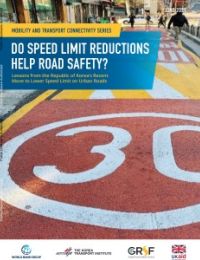
Significant research has been undertaken on how changes in speed limit—for example, the introduction of 30 kilometers per hour, or kph (20 miles per hour, or mph) speed limits—impact safety both when combined with, and without "traffic-calming" engineering treatments such as speed humps or raised platforms. However, most of the studies have been conducted in Australia or countries in Western Europe, with almost no recorded studies from Asia, Africa, the Americas, and Eastern Europe. Though it may be reasonable, a well-developed infrastructural environment such as that found in Korea would expect similar results as that of the western countries, a study originating in Asia could have a strong demonstration effect and prove very convincing for many Asian countries.
With this in mind, the main aim of this study is to present the findings from Korea’s reduced speed limits on safety performance and to support the establishment of suitable speed-management strategies based on a quantitative data-driven approach. The scope of the project was as follows:
To start, this report first provides a brief literature review on the concept of Safe System speed limits, and the effect of speed limit reductions as part of speed management in several countries, followed by a brief description of the evaluation methods for the before-after assessment. This is followed by a summary of the findings, a set of recommendations, limitations of this study, and finally, a capsule of future research that could be undertaken to either extend or follow up on the study.

